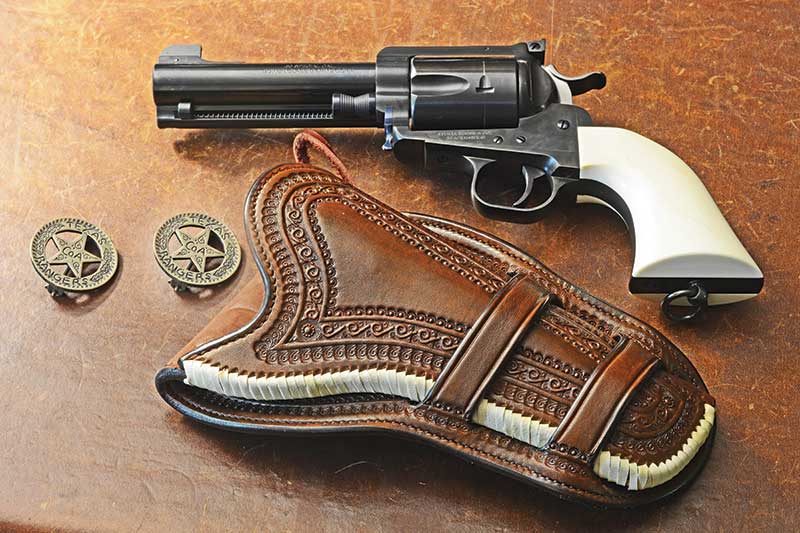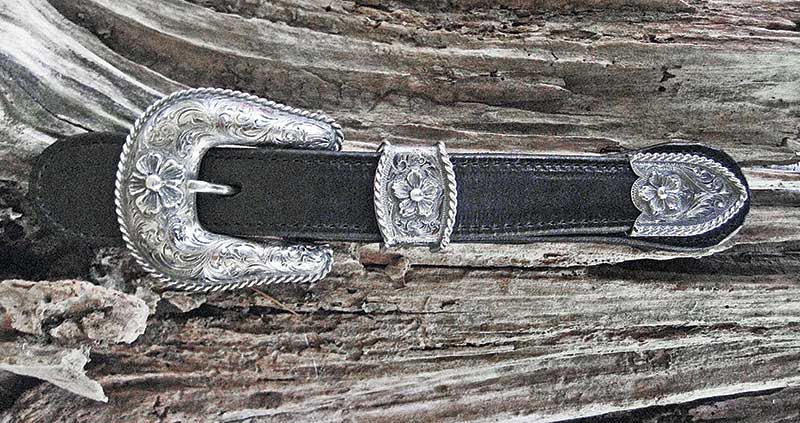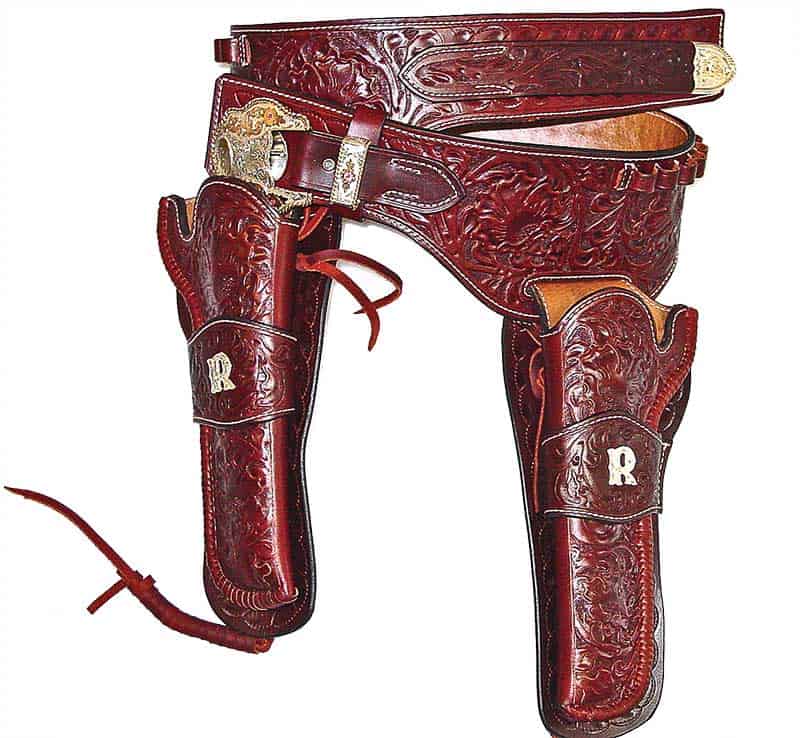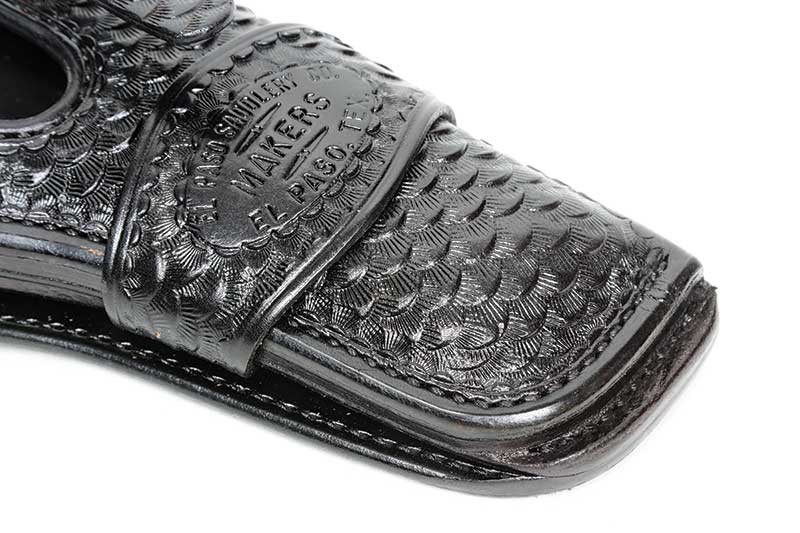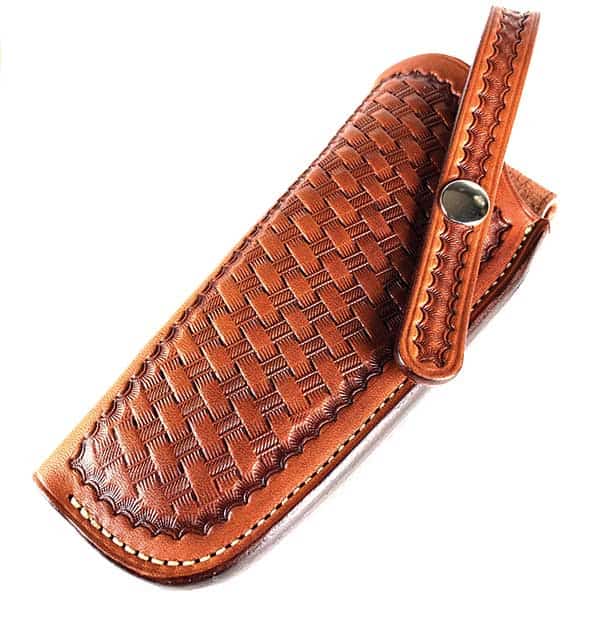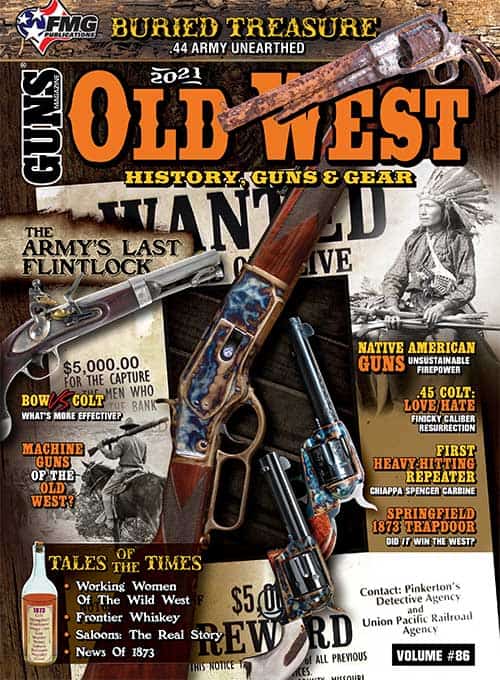Western Holster Evolution:
The Roots Of The Design
Western holsters are some of the most beautiful, stylized and iconic pieces of gunleather in existence — especially those from the 1910s. The West was still in full wild swing, but the guns had evolved into things we still use today, like 1911 pistols, pump shotguns, etc. But a “Western holster,” no matter what the silver screen shows us, is not a singular thing, and much of the history is lost in the mist and, in many cases, myths of time.
The earliest holsters were attached to saddles so cavalry troopers could carry a brace of single-shot flint or percussion “pistols” strapped across their saddles. As the guns got smaller and became repeaters, these ungainly creations were replaced by belt-mounted flap holsters carrying a soldier’s percussion revolver, often butt-forward. This design held steady for military use until relatively recent memory.
The need for the flap to protect cap-and-ball revolvers lessened as the wearers moved into the arid climate of the West. There, a powder-dampening rainstorm wasn’t as likely, not to mention, as Skeeter Skelton helpfully pointed out, in anything other than a short cloudburst, that flap was going to get soaked. Nothing good can come from soggy leather holding its moisture near the charged cylinder of your blackpowder gun.
Other changes came because the settlers were moving into a world where most manufactured goods had to be transported from the east. This meant things like hardware were in short supply. Jack Weaver once told me about going into ghost towns where settlers had roofed the buildings with the tin left over from canned goods. They had unrolled the cans flat — after melting out the solder to cast bullets!
Minimalist Methods
Snaps, buckles and studs likewise were among the items in slim supply, so the first indigenous holster style was, unsurprisingly, very much a minimalist design. The California or “Slim Jim,” was a narrow, form-fitting scabbard closely following the contours of the long-barreled black powder revolvers of the era — such as Hickok’s favored Colt 1851.
The mouth of the holster is usually cut in an S-shape, exposing part — or all — of the trigger. Unlike wartime where one had some expectation of when a gun might be needed, a man in the West was likely to need his pistol in a hurry.
With time, the Slim Jim evolved into the Mexican Loop, beginning what most of us picture as a traditional Western holster. The pouch holding the gun maintains the same lines as the Slim Jim, but the back part of the pouch continues upward in a large flap folded downward, creating a wide skirt or “fender” behind the pouch. Slits are cut into the skirt, with each pair of slits creating a “loop” into which the pouch is pushed. The loops hold the body of the holster in place and the fold at the top creates a broad belt tunnel.
In addition to minimizing the need for hardware such as rivets, the broad skirt and belt loop of the Mexican Loop help distribute the weight of a big sixgun across the belt. The loops themselves, though (the number of which varied) did not necessarily present enough friction to keep the pouch firmly in place.
A later regional variation called the “Cheyenne” has a distinct bump between the loops acting as a detent to hold it in place. The Cheyenne also has a stitched-in teardrop-shaped toe plug to keep debris out of the muzzle, helping to maintain the shape of the holster.
Belts
With the change from percussion to self-contained cartridges came the cartridge belt, lined with loops for holding extra rounds. The most popular version, the money belt, is made of a wide piece of soft leather folded down its centerline and stitched to create a surreptitious place to hide cash, gold or silver coins or papers. Rather than closing the belt with a massive buckle the full width of the belt (which could easily be 3″ or more), a smaller buckle was often attached to a narrower piece of leather called a chape, and a matching billet was stitched to the other end of the belt. Buckles tended to be square with the corners clipped, a design called the California, but the fancier Ranger-style buckle sets incorporating a metal belt loop and tip for the chape also made their appearance.
The so-called “buscadero” rigs dispensing (or flouting) justice on a thousand silver screens, however, was utterly unknown — it’s a Hollywood creation. Instead of a separate belt with a holster sliding over it (and riding comparatively high), the buscadero has a broad belt dipping down near the holster, cut with a horizontal slot through which the folded-over top of the holster fits.
Beautiful, but hard to make well, it puts the gun in a very low ride along the thigh. It looks great in movies but would have been quite uncomfortable on horseback, and fairly likely to dump the gun out while riding. Impractical though it may be, it makes for an impressive visual.
The Brill
The next milestone is the creation of the Brill holster, so named because of its best-known maker, A.W. Brill of Austin, Texas. In addition to its distinctly Western style, the Brill added the element of concealability. The alert mind will recognize Austin as the headquarters of the Texas Rangers who, shortly after the turn of the century, found themselves stabling their horses and saddle scabbards. Instead, they were walking around in cities where their frontier appearance, bristling with all the hardware required to survive alone in whatever one riot to which they were summoned, wasn’t exactly socially acceptable. They needed to hide their guns.
Though clearly an evolution of the Mexican Loop design, the Brill accomplished its concealment goals by being made of lighter leather, riding higher than traditional loop holsters and streamlining the rear skirt to reduce bulk.
Like most things, though, the Brill did not simply spring into being fully formed. Around the turn of the century the King Ranch, known for providing horses to the Rangers before there were Ford trucks, created a Mexican loop variation with many of the features later defining the Brill. The multiple loops were replaced with a single, broad cuff, and the toe of the holster pouch was stitched to the skirt, which was trimmed somewhat.
In 1907, at the request of Texas Ranger N.J. Rabensburg, the basic design changed into the canonical Brill, whose skirt was further trimmed down to the profile of the holster pouch.
The end result is a practical holster keeping the gun tucked up close against the body, tilted at an FBI-like rake for concealment and a fast draw, but still with an unmistakably Western flair. Of all the Western designs, it and its stripped-down progeny, the Threepersons, are probably the most practical for modern use.
It was well received by the Rangers. Tellingly, most of the contemporary makers were located relatively close to Austin, and modern reproductions are often named with some reference to the Rangers.
Nor is the Rangers’ love of the Brill simply a matter of history. H. Joaquin Jackson, one of the most famous Rangers of my lifetime, who was depicted on film by Nick Nolte in Extreme Prejudice and Jeff Bridges in Hell or High Water, preferred the Brill. In 2005, Jackson said it had “never been surpassed in efficiency, utility and beauty.”
No less than Skeeter Skelton described his first “real” holster as a Brill given to him for his 4 3/4″ Colt SAA by a retired Texas Ranger. Interestingly, though, four years before, in 1968, Skeeter wrote his first good holster was a Myres Threeperson, and the emphasis on good may explain the apparent contradiction. He felt it was entirely unnecessary for a holster’s backflap to be “flaring out fore and aft like Aunt Mattie’s sunbonnet.”
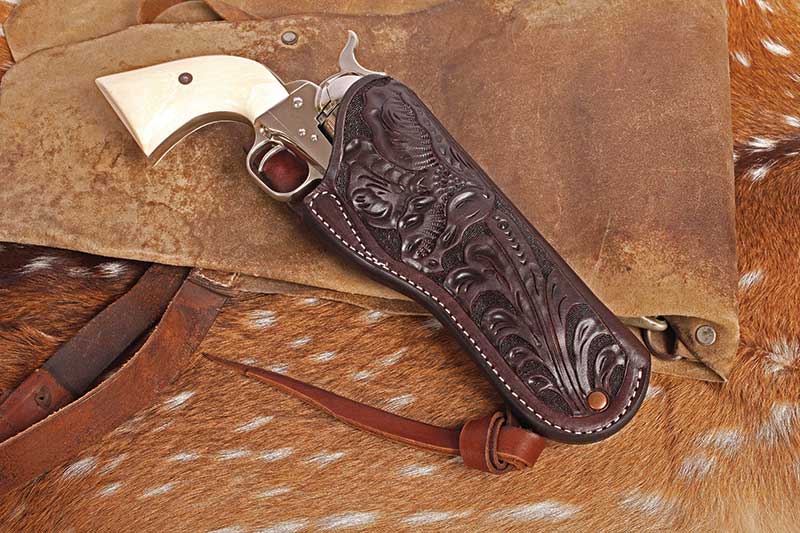
A Threepersons modeled after one carried by Tom himself. The original lives
in a museum and is well documented. As is the case with the real “gunfighter” rigs,
note the cutaway trigger guard area. It was all about accessing the gun fast, not
about protecting it. Holster is by Red Nichols. Photo: Roy Huntington
Threepersons
To turn a Brill into a Threepersons, legendary lawman Tom Threepersons completely removed the skirt from the Brill and brought the gun up higher on the belt, still at an angle comparable to the FBI rake. Instead of the skirt and cuff serving as the belt-loop tunnel, the top of the holster was folded backward and stitched to the body of the holster, where the cuff would usually be, instead of down at the toe. Simpler and requiring less skill to make than the complicated Brill, it also weighed less, addressing one of Elmer Keith’s criticisms of the Mexican Loop design.
It’s appropriate to refer to Tom Threepersons as “legendary,” since there’s very little definitively known about him. Cherokee by self-report, the best that can be sorted out is he took the name of a Canadian Blood Indian who was the first to win at a rodeo in 1912. He then enlisted in the U.S. Army under the name, where he reportedly served as a scout for later-General George S. Patton in 1916 during Pershing’s Punitive Expedition into Mexico. He subsequently worked in law enforcement for a brief but shockingly violent seven years during which he “plowed his way into tight holes and very calmly shot his way out,” according to the El Paso Times. It says a lot the Times wrote the description in 1922, only two years into his tenure as an officer.
It was in El Paso Samuel Dale “S.D.” Myres, holstermaker extraordinaire (and oddly a reputed confidante of Pancho Villa) produced a simplified Threepersons holster. Some of the original copper patterns used by Myres are now owned by holstermaker Mike Barranti, who uses them to make his faithful Threepersons holster.
Ed McGivern, Bill Jordan, Elmer Keith and many others appreciated the simple, fast design principles of the Threepersons, and those principles were clearly discernible in duty-holster design right up to the current Kydex era. What it gains in simplicity, though, the Threepersons gives up in style, which in a sense makes the Brill the last of the distinctively Western holsters.
It’s fine with me, since it still carries easily under a jacket.
For more info:
www.barrantileather.com
(412) 860-4804
www.epsaddlery.com
(915) 544-2233
www.purdygear.com
(706) 692-5536
Texas Ranger Hall Of Fame And Museum
www.texasranger.org
(254) 750-8631
